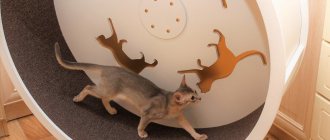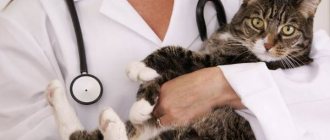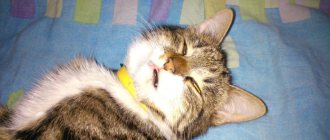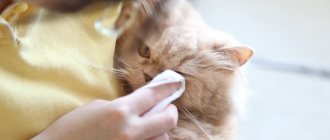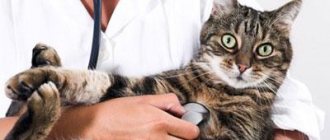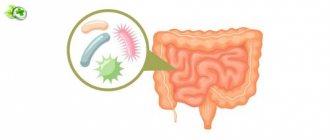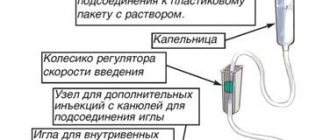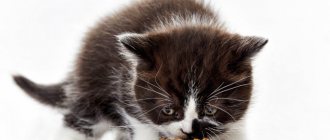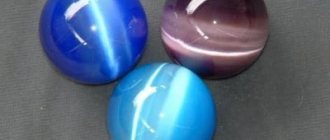10150Pavel
2
Like all animals, cats unfortunately get sick. They have a runny nose, sneezing, and cough. Therefore, animal owners need to know how to rinse their cat’s nose if he is sick. A cold or respiratory tract infection can occur at any time, especially during the autumn-winter and spring-summer transitional climate periods. The cat eats and drinks poorly, becomes lethargic, has difficulty breathing due to nasal congestion, he sneezes and tries to free his nose from snot. The pet will need your help.
How to rinse a cat's nose
Instructions
Contact your veterinary clinic if you notice any abnormalities in your cat's health. The discharge of mucus from the nose can indicate not only a common runny nose, but also more serious diseases.
The doctor will examine your pet and take tests. After this, he will prescribe treatment, which will include not only taking medications, but also rinsing the nose if the cat has difficulty breathing. You can purchase all medications at a veterinary pharmacy. Follow the general instructions. But if everything is more or less clear with tablets and suspensions, then rinsing the nose is somewhat more difficult.
Prepare saline solution for rinsing, it should be at room temperature. You cannot use a saline solution, as it contains iodine, which can provoke the development of allergies and swelling of the mucous membrane.
Remove the needle from the syringe or use a regular pipette to rinse. Fill up the solution in advance and only then pick up the animal.
If you have a calm cat, then place it on your lap and, holding it lightly, drop drops on its nose. About 0.5 mg of solution per nostril is sufficient. If the animal becomes very anxious, ask someone to hold it. Try not to scare your pet so as not to traumatize its psyche.
Rinse us with koshe about 3 times a day. When improvements occur, carry out the procedure only in the evening. On average, an animal's runny nose will go away in 4-6 days. If no improvement is observed, visit the veterinary clinic again and consult with your doctor.
Remove any remaining moisture from the animal's nose by blotting it with a clean handkerchief.
In cats, as in people, many diseases are accompanied by an increase in body temperature. And when contacting a veterinarian for advice, the question is often asked about whether the animal’s temperature is normal. But how to take a cat's temperature?
Instructions
In order to measure a cat's temperature, you can use a special veterinary thermometer, or you can use a regular, “human” one. Both a mercury and an electronic thermometer will work. But if you have a choice, it is better to use an electronic one - they work faster, and the less time it takes to measure the temperature, the less nervous your pet will be. The tip of the thermometer must be lubricated with Vaseline or cream. Place your cat on your lap or on a table and try to keep her standing still. If the cat is nervous and breaks out, you can wrap it in a sheet or towel, leaving the back of the body free.
Raise your tail and very carefully insert the thermometer into the rectal opening (to a depth of three to four centimeters). This should be done smoothly, with light twisting movements, so as not to cause pain to the cat.
If you use a mercury thermometer, you need to measure the cat’s temperature within five minutes, if you use an electronic thermometer, before the thermometer beeps. Normal temperature for cats is considered to be between 38.5 and 39 degrees Celsius. True, in small kittens or cats that were nervous or ran a lot before measuring their temperature, the temperature may be slightly elevated (up to 39.5 degrees). In cats of hairless breeds, normal body temperature can be even higher - up to 43-46 degrees.
After finishing measuring the temperature, remove the thermometer and wash it thoroughly with soap. You can also disinfect it by wiping it with alcohol or cologne.
Video on the topic
note
If a cat does not allow its temperature to be measured, twitches violently and breaks out of your hands, do not try to forcefully insert the thermometer, otherwise you may accidentally injure the animal.
Sources:
- I'll take my temperature in 2017
Modern cars equipped with injectors have many advantages over outdated carburetor models. But over time, when you have to use low-quality fuel, the elements of the injection power system require preventive cleaning. This can be either liquid (chemical) or ultrasonic cleaning.
The operating conditions of cars in Russia make periodic washing of the injector an absolutely necessary procedure. Firstly, because the conditions for the production of 92nd and even more so 95th gasoline leave much to be desired. Not to mention the production of '98. Secondly, all brands of gasoline are stored in the same tanks. Over time, tar deposits accumulate in them. High-octane grades of gasoline dissolve them, and when refueling, the fuel oil goes into the tanks of cars, clogging the fuel system. Thirdly, the use of additives that increase the octane number of gasoline in our country is very large.
We suggest you read: Metastases in the lungs of a cat
Therefore, on cars with an injection power system, fuel lines, injectors and other injection systems require preventive cleaning approximately every 20-30 thousand kilometers. If the total mileage of the car is low, liquid cleaning is used. On models with high mileage, in cases where the power system has not been cleaned for a long time (or not at all), difficult to remove deposits accumulate that are inaccessible to the chemical cleaning method. In this case, ultrasonic cleaning of the fuel injection system is used.
Signs indicating the need to flush the injector are: - unstable idling; - difficulties when starting the engine; - dips that appear when the accelerator pedal is sharply pressed;
– reduction in acceleration dynamics and power indicators;
- misfires of the engine cylinders; - frequent cases of detonation; - popping noises in the muffler;
– periodic failures of spark plugs, oxygen sensor (lambda probe) and catalyst;
- decreased fuel efficiency; - increased toxicity of exhaust gases (CO-CH content).
With the onset of the winter period of operation, these signs intensify and become especially noticeable. This is due to the natural deterioration of fuel volatility, leading to difficulty starting the engine.
After the injector flushing procedure, the spark plugs must be changed. It is also very useful to replace the engine oil and oil filter, since there is a possibility of flushing fluid getting into the lubrication system.
Itching in the nose area can be either external, when there is a desire to scratch the affected area of skin, or internal. There are many reasons for this phenomenon, ranging from skin diseases to excessive dryness of the mucous membranes. As a rule, an itchy nose can be dealt with fairly quickly by using home remedies, as well as nasal drops made with essential oils. But if they don’t help and your nose continues to itch, you should definitely consult a doctor.
Constant itching of the skin of the nose can be caused by skin diseases - eczema, neurodermatitis, psoriasis, and some types of lichen. In addition, the nose may itch due to scabies (a disease caused by scabies mites), as well as when abrasions and scratches are healing. There are cases when the skin of the nose itches due to diseases associated with the endocrine system, for example, diabetes.
Burning of the skin of the nose also occurs due to sunburn or bites of blood-sucking insects - mosquitoes, bedbugs.
The most common cause of periodic itching of the nose from the inside is an allergy to some external irritant. For example, in spring and early summer, many people suffer from so-called hay fever, or hay fever. This disease is caused by pollen of certain plant species, which provokes an allergic reaction in the body.
You can alleviate the symptoms of hay fever by taking antihistamines, rinsing your eyes and nasopharynx with water or herbal decoctions, and using a protective gauze mask. If the allergy is severe, you should move away from the allergen during flowering.
Allergies can also be caused by pet dander, dust, certain foods, drinks, and medications.
In these cases, it is necessary to identify the allergen and minimize the likelihood of contact with it. The nasal mucosa can also itch when it becomes too dry. This usually occurs when air humidity is low (for example, during dry and hot summers or during the cold season, when living spaces are often heated by heating devices). To get rid of dryness, you need to rinse your nose with sea water.
Finally, the nasal mucosa can itch due to nervousness, that is, during anxiety or stress. After the traumatic situation passes, the burning and itching of the skin of the nose, as a rule, quickly ends. If the itching does not go away for a long time, or intensifies, you need to contact a specialist to conduct tests and prescribe the necessary treatment.
Nasal polyposis occurs due to the appearance of polyps in the nasal cavity and sinuses. The progression of the disease leads to difficulty breathing, headaches and a general deterioration in the patient’s condition.
Nasal polyposis is a pathological condition that is accompanied by the formation of polyps in the nose. By their nature, polyps are growths of the mucous membrane of the nose and paranasal sinuses, resembling bunches of grapes in appearance. Polyposis is a polyetiological disease, the cause of which can be allergic diseases, bacterial, viral and fungal infections. At the first stage of the disease, the mucous membrane grows in the upper parts of the nasal cavities, in the maxillary sinus and the ethmoid labyrinth. Polyps gradually increase in size, narrowing the respiratory lumen and causing difficulty breathing. Patients begin to complain of a constant feeling of nasal congestion, a nasal voice, headaches, chronic fatigue and decreased performance. As polyps grow, the olfactory receptors may become damaged, causing the patient to lose the ability to distinguish and smell. In addition to these symptoms, patients with polyposis are bothered by mucous or mucopurulent discharge from the nasal cavity, dryness in the nose and throat due to blockage of breathing during sleep. Usually, the diagnosis of polyposis is made during an initial examination by an ENT specialist, after examination by endoscopic and rhinoscopic methods. To determine the extent and mobility of polyps, probes and video cameras are used. If surgical intervention is planned, the doctor will definitely prescribe an x-ray or tomography. Treatment of polyposis is carried out conservatively and surgically. The best results are achieved by an integrated approach: removal of polyps plus subsequent drug treatment aimed at preventing relapses. Today, the most common type of surgical treatment for polyposis is endoscopic polysinusotomy. The operation is carried out under the control of an endoscope and allows you to remove polyps not only from the nasal cavity, but also from the nasal sinuses. During the procedure, those sinuses in which polyps are found are opened and their good drainage is ensured, which is important for further therapy.
We suggest you read: How to care for a Siamese kitten for 1 month. Caring for a Siamese cat
In what situations is this needed?
Many diseases affect a pet's respiratory system. Cats often suffer from viral, bacterial, and fungal diseases, which are almost always accompanied by nasal congestion. A simple cold after hypothermia or being in a draft leads to copious discharge from the nostrils and swelling of the mucous membranes, which makes it difficult to breathe freely.
Injuries to the head and, in particular, the nose, leading to breathing complications, are also quite common. Often, cancer affects breathing (neoplastic tumors can block the nasal passages). Swelling of the nasal mucosa, which leads to narrowing of the nasal passages, often occurs due to allergic reactions. There are many examples, it is important to quickly determine the cause and take appropriate measures to alleviate the pet’s condition.
Cat nasal discharge
Some problems can be easily identified on your own by carefully examining your pet's nose. It is important not to ignore your cat's suspicious behavior and pay attention to the following symptoms:
- hoarse, heavy breathing;
- whistling sounds;
- snoring, snoring, gurgling, etc.;
- discharge from one or both nostrils (green, brown, clear mucus, pus, blood, etc.);
- wounds on the face, head, in particular on the nose;
- breathing complications after a fall, a blow to the head, or similar injuries even without visible external changes;
- the cat sticks out its tongue and opens its mouth all the time;
- lack of nasal breathing, the cat breathes through its mouth all the time;
- the pet often rubs its face with its paw;
- noticeable lacrimation;
- hypersalivation (excessive salivation);
- poor appetite;
- general unsatisfactory condition - lethargy, apathy, constant drowsiness;
- bluish visible mucous membranes;
- redness of the mucous membranes, redness of the eyes.
Problems with nasal breathing can also be caused by simple dirt that has dried on the face and prevents the normal flow of air through the nostrils.
You can easily clean ordinary dirt yourself, which will help your pet. In other cases, it is necessary to contact a veterinary clinic, where the doctor will conduct a thorough examination, identify the problem and prescribe treatment. You can’t put off going to the vet so as not to worsen the situation.
After determining the cause of nasal breathing problems, the veterinarian will prescribe appropriate treatment, often including rinsing the nasal passages. This manipulation can be carried out in a hospital, or at home. It is important to strictly adhere to the recommendations of your doctor, use prescribed medications and carefully monitor the dynamics (changes) of your pet’s recovery.
Causes
A runny nose in kittens occurs for the following reasons:
- Dampness and drafts. You should not over-ventilate the room and take your pet out for a walk in humid or damp weather.
- Feeding a supercooled delicacy, such as milk from the refrigerator or frozen fish.
- Sudden temperature changes. During the transition period, when the heating is turned off, it is necessary to provide the kitten with heating. In hot weather, you should not leave your baby in the air conditioner area.
- Allergic reaction. The cub may react inappropriately to smoke, pollen of angiosperms, perfumes, and solvents. Choch provokes the smell of new furniture or unusual food. In addition to a runny nose, profuse salivation may occur.
- Infectious pathologies. Most infectious diseases are accompanied by rhinitis. Rhinotracheitis, Calcivirosis, and Panleukopenia pose a threat to life.
- Congenital anomalies. A kitten born with a crooked nose constantly sneezes. He has continuous leakage.
With Calcivirosis, conjunctivitis develops along with a runny nose
We focus on food
- One of the most common treatments is appetite stimulation. The essence of the method is that an animal with a clogged nose cannot smell food, so its craving for food sharply decreases and, over time, a loss of strength occurs.
- You can help restore the vital energy that is so necessary to fight the insidious infection by offering your cat something that smells very appetizing. It could be delicious fish or meat, or some special dish that your pet likes.
- If your pet is accustomed to cat food, then offer him a canned version, which, unlike dry food, has a more pronounced aroma. If the animal does not want to eat, then you can lubricate the cat’s nose with sour cream or pate. The focus on cleanliness should work here; the cat will definitely lick its nose and, perhaps, taste the deliciousness.
How to rinse a kitten's nose? (calcivirus)
Previous Entry | Next Entry
ru_vetkittiarra Good night. I really need advice on rinsing the kitten’s nose. Briefly: the kitten’s diagnosis is calcivirosis. We went to the vet and did everything we were prescribed. The condition is stable and serious. The day before yesterday and yesterday it was very bad, there was pus and blood coming from the nose and mouth, I was breathing heavily. We rinsed her mouth, alternated chlorhexidine, miramistin and oak root decoction. They also tried to wash out my nose. Through a syringe without a needle and even through a small children's enema. But it doesn’t work out very well, the kitten screams and squirms, it hurts, because there are ulcers and inflammation. As a result, we got used to rinsing and treating the oral cavity, it heals there, but rinsing the nose is a real problem. Today her condition seems to be better, but now she has started trying to sneeze and cough up, it is clear that she is breathing heavily, through her mouth, sometimes even in jerks. There is less such terrible discharge from the nose, but the nose is clearly clogged tightly. We need to do something somehow, but the vets told us to do the washing ourselves and not to drag her down the street in this condition because of such a trifle. She's so weak now that I'm just afraid that she might choke while washing, or that I might injure her accidentally. Please tell me how to rinse her nose and how to do it correctly? Is it possible to rinse with chlorhexidine or some herbs from a syringe, or something else? In general, what should I do? Ps - I’m especially interested in how much rinsing liquid to use, at what intervals, and most importantly - can you rinse with strong pressure on the syringe so that there is a direct stream, or do you need to quietly pour in drop by drop? ?
Thank you in advance!
A runny nose in a kitten is a mucous inflammation of the animal's nasal membrane. At first glance, a runny nose in animals is a harmless disease that is very common in small kittens and adult cats. But this disease should not be left to chance.
In the cold season, a runny nose is the most common phenomenon - both in people and animals. When a runny nose appears in kittens, it is necessary to deal with it immediately. The veterinarian must prescribe treatment and prescribe the necessary nasal drops.
We invite you to read: How to care for a kitten: tray, litter and diet? Cat in the house, how to properly care for a cat
Caring for kittens when they are sick should be done daily. It is necessary to instill drops after the tailed cat’s owner clears the sinuses of snot. For this whole procedure, you need to purchase a bulb at the pharmacy to suck out the mucus from the kitten’s nose.
The pear is intended for human needs, but it can be used to treat an animal. Phyto- and homeopathic preparations are safe for kittens during illness. You need to know that when kittens get a cold, two nasal passages are affected at once. For babies, you can instill drops that are intended for children against a runny nose.
How to wash a kitten's nose is not an easy task, but it is doable. When drops are instilled into a kitten's nose, the animal may experience a burning sensation, dryness, sneezing and a sore throat, and the kitten may snort at this moment. During a cold, kittens may experience drowsiness, lethargy and weakness, apathy and refusal to eat.
In sick kittens, after a couple of days, discharge from the nose begins, noise in the ears, and the temperature may rise. The cavity around the nose can be treated with Vaseline. During treatment, it is important to regularly wipe mucus from the nose. Kittens need to be given more water to drink. During this period, pets need sleep and rest. Let them sleep and get better.
Cleaning from dirt
Veterinarians say that the animal's nasal passages clear themselves, so intervention is usually not required. But if your cat is acting restless or exhibiting other symptoms, she should have her nose cleaned.
The washing steps should be as follows:
- Draw boiled water at room temperature into a syringe or pipette.
- Immobilize the pet using a clothespin at the withers or wrapping it in thick material.
- With one hand, support the animal by the head, and with the other, pour in the solution in a thin stream. Liquids are drawn into the syringe no more than 0.5 ml.
- After rinsing one nostril, the manipulation is repeated with the other.
- Remove dirt with a cotton swab.
It is important to calm the animal. To do this, it is recommended to stroke it. Upon completion of the procedure, the pet must be rewarded by giving it a favorite treat.
The most dangerous diseases
A runny nose is a symptom of the most dangerous viral diseases:
- Calcivirosis.
- Rhinotracheitis.
- Panleukopenia.
Calcivirosis
An extremely contagious viral infection. Characterized by fever, rhinitis and stomatitis. Kittens taken from their mothers become ill.
Those who recover gain lifelong immunity, but become spreaders of the virus. If the disease is not treated, 30% of clinically ill patients die.
Ulcerative stomatitis is considered a striking additional symptom. This makes it difficult for the kitten to swallow. He refuses to eat and loses weight. Gingivitis occurs, characterized by inflammation of the gums. A runny nose is accompanied by a cough, and bronchopneumonia develops. If pulmonary edema occurs, the kitten dies.
Rhinotracheitis
Rhinotracheitis is caused by the herpes virus. Develops rhinitis, conjunctivitis and tracheitis. The kitten cries and sneezes, having recovered from the disease, it becomes a carrier of the virus, gaining lifelong immunity. Hypothermic cubs and unvaccinated individuals become ill. Unbalanced nutrition and overcrowding increases the risk of epizootics.
The signs of the disease are similar to the symptoms of Calcivirosis, but the ulcers do not appear on the mucous membrane of the mouth, but on the cornea of the eye. In kittens, necrosis of nasal tissue and bone resorption are observed.
Rhinotracheitis
Panleukopenia
Panleukopenia is a dangerous disease with high mortality. Survivors within 100 hours become reservoirs of Parvovirus. Contagium is transmitted by blood-sucking exoparasites.
There is no placental barrier; kittens receive the virus in utero. Intermittent fever is characteristic. First, body temperature rises 2 °C above normal, and after 2 days it drops 1 °C below the limit.
The pulmonary variant of panleukopenia is characterized by purulent discharge from wear and tear and eyes. Cloudy films and hemorrhages appear on the mucous membranes. The mortality rate is, on average, 50%.
Panleukopenia
Basic principles of the procedure
The main problem in trying to put drops on a cat's nose is the animal's mobility. Any procedures should be accompanied by some restriction of movements, which the pet will not really like. Clinics often have special devices for this. However, in home treatment conditions it is not easy to achieve such a result. It is for this reason that many owners do not know exactly how to apply nose drops, especially to a kitten.
First you need to decide on the right tool. It is not recommended to drop the solution using a standard pipette. And the option that comes with the medicine is not always suitable. The ideal solution would be a regular small syringe. Naturally, it must be used without a needle.
Regarding the position of the cat at the moment when the owner tries to instill the drug into the pet, there are several options:
- scruff of the neck;
- immersion in felt boots;
- collecting animal paws in a lock.
Regardless of the method chosen, it is best to bury the cat’s nose in pairs. In this case, one person will hold the animal in a comfortable and pain-free position, and the second will quickly carry out the necessary manipulations.
It is highly discouraged to use homemade medicines in this process. Many people think that dripping the juice of an onion or other vegetable, as was done before, is a good solution. However, for the safety of the pet itself, you should follow the veterinarian's instructions. In addition, it is extremely important to fully comply with the instructions and dosages indicated on the drug.
Treatment
The concept of treating viral diseases of kittens accompanied by a runny nose is developing in the following areas:
- Antimicrobial therapy. It is almost the same for all viral diseases.
- Symptomatic treatment. To eliminate a runny nose, the same treatment strategy is used. As for other symptoms, treatment has its own specifics for each pathogen.
Use the following means:
- Antiviral. On the first day of illness, Vitafel is used in the form of immunoglobulin or serum containing antibodies against Panleukopenia, Rhinotracheitis and Calcivirosis. Late passive immunization is ineffective: viruses fade into the background, and the fight against secondary microflora becomes urgent.
- Are common. Immunostimulants that stimulate the immune response are indicated. The following drugs are in demand:
- Cycloferon.
- Immunofan.
- Phosphprenyl.
- Gamavit.
- Derinat.
- Antibiotics. Necessary to prevent the development of secondary microflora that causes a runny nose, lacrimation and other symptoms.
To eliminate signs of rhinitis, use nasal drops:
- Anandin.
- Maxidin.
- Thymogen.
If there is no positive effect, the following medications are allowed for use under the supervision of a veterinarian:
- Naphthyzin.
- Dioxidine.
- Nazivin.
- Galazolin.
Nasal drops
Anandin
One of the most common drugs for the treatment of rhinitis. In addition, the medicine can be used in the treatment of diseases of the eyes and ears.
The composition includes glucaminopropylcarbacridone, which has a pronounced anti-inflammatory effect. In addition, the active substance enhances the local and general immune status of the body. The following indications for use are distinguished:
- Rhinitis of bacterial and viral origin.
- The product can be used as an auxiliary medicine in the treatment of fungal inflammation of the nasal cavity (Anandin alone cannot cope with fungi).
- In addition, the medicine helps to cope with rhinitis of allergic etiology.
There are usually no difficulties when using the drug:
- For mild rhinitis, drop two drops into each nostril twice a day. The period of use is approximately a week.
- In the case of rhinitis with moderate and severe intensity of the inflammatory process, the dose can be increased to three or four drops in each nostril, the frequency of use can be increased to three times a day. The duration of use in this case should not exceed two weeks.
Prevention
To prevent runny nose in kittens, adhere to the following recommendations:
- Compliance with sanitary standards.
- Balanced feeding.
- Quarterly deworming.
- Preventing contact with allergens.
- Immunization. They use the drugs Multifel-4, Nobivak, Tricat. Quadricat. 7 days before vaccination, kittens are dewormed. Babies are first immunized at 8 weeks, followed by instructions on how to use the vaccine.
Vaccine against calicivirus, panleukopenia, rhinotracheitis
Caring for a sick kitten plays a decisive role in treatment. Crusts of drying exudate constantly form on the nose. They are wiped regularly, 8 times a day, and treated with medications.
Kitten toilet
As for the toilet, with the development of a specialized industry that produces products and care products for animals, there are no longer problems with cat litter. These special plastic trays with mesh, as well as litter for such litter boxes, can be purchased at any specialized store that sells pet products.
How to toilet train a kitten
Your main task is to accustom the kitten to this toilet. But, again, manufacturers of pet products come to the aid of cat owners by producing special toilet training sprays. All you have to do is spray this spray on the cat litter box and wait for the result.
How to choose a place for a cat litter box
Whether you correctly determined the location of such a cat litter box in your house or apartment depends on how quickly the result comes and the kitten learns to go to the toilet in a specially designated place. It should be a fairly secluded, quiet, comfortable and calm place, without unnecessary light and noise. Then the kitten will not be afraid to go to such a toilet.
Treatment frequency
It is not recommended to regularly clean your pet's nose. Usually the dirt is removed on its own.
Expert opinion
Kalado Irina Sergeevna
Practicing veterinarian, 13 years of experience.
Experts advise washing once every six months. Frequent manipulation can lead to undesirable consequences for the animal.
If necessary, when you need to cure a runny nose, the procedure can be done for three days in a row. Usually the snot goes away after the first wash .
If the actions do not give any result, then you need to contact a specialist.
You can rinse your cat's nose, but this should be done if the runny nose does not go away or if the nasal passages are clogged, which prevents the animal from breathing normally.
Previous
Care: Is it possible to bathe a cat with regular human shampoo?
Next
Care for a cat's oily fur: causes and treatment methods
